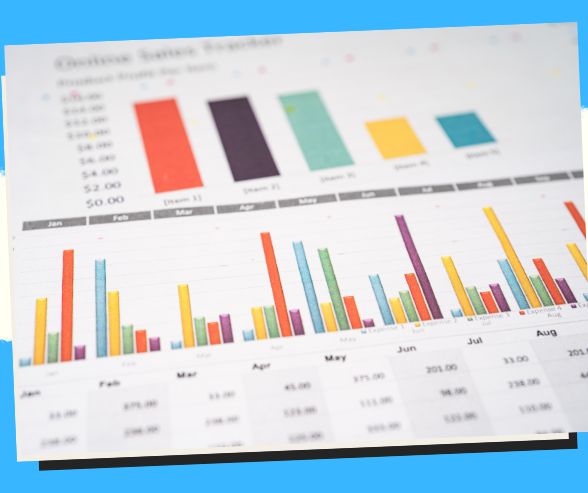
Data Unleashed: Harness the Magic of Visualization for Business Insights! 🚀
Unleash the magic of data with visualization and unlock new business insights! Dive into the world of possibilities. 📊
Unveiling the Power of Data Visualization for Business Insights 📊🔍
In the age of information, data isn’t just about numbers and statistics; it’s a treasure trove of insights waiting to be discovered. But how can businesses unlock the true potential of their data? The answer lies in data visualization—a dynamic tool that transforms raw data into meaningful stories. 🌟💼
In this article, we’ll embark on a captivating journey through the world of data visualization and its pivotal role in providing businesses with actionable insights. Whether you’re a data enthusiast, a budding entrepreneur, or simply intrigued by the art of turning data into wisdom, this article is your trusted companion. So, let’s dive deep into the vibrant realm of data visualization and discover how it can illuminate the path to business success. 🚀📈📊
The Essence of Data Visualization
Before we embark on our journey, let’s take a moment to grasp the essence of data visualization.
🔍 Purpose: Data visualization is the art of representing data graphically to aid understanding and decision-making. It transforms complex datasets into visuals that are easier to comprehend.
📊 Forms: Data visualization takes various forms, including charts, graphs, maps, dashboards, and infographics. Each form serves a specific purpose, from illustrating trends to comparing data points.
🚀 Benefits: The primary benefits of data visualization are clarity, accessibility, and the ability to reveal patterns, trends, and outliers that might be hidden in raw data.
📈 Tools: A wide range of tools and software exists for creating data visualizations, from simple spreadsheet applications to specialized data visualization software like Tableau and Power BI.
📊 Audience: Data visualizations are designed for a specific audience—ranging from business executives seeking high-level insights to data analysts exploring granular details.
🌟 Impact: When used effectively, data visualization empowers organizations to make data-driven decisions, improve communication, and identify opportunities and challenges.
Now that we have a foundation, let’s explore how data visualization can bring a wave of transformation to the business landscape.
The Power of Data Visualization
Data visualization isn’t just about making data pretty; it’s about making data insightful and actionable. Here’s why it’s a game-changer for businesses:
1. Clarity in Complexity
Challenge: Businesses deal with vast amounts of data daily. Understanding complex datasets can be overwhelming, and critical insights can get lost in the noise.
Solution: Data visualization simplifies complexity. It transforms intricate data into visual patterns that are easy to grasp at a glance, making it simpler for decision-makers to understand trends and correlations.
2. Uncovering Trends
Challenge: Businesses need to stay ahead of the competition by identifying emerging trends and opportunities.
Solution: Data visualization allows organizations to spot trends and patterns in their data quickly. By tracking key metrics over time, businesses can make informed decisions about product development, marketing strategies, and market expansion.
3. Effective Communication
Challenge: Businesses often struggle to convey complex data and insights to stakeholders, both internally and externally.
Solution: Data visualizations serve as a universal language. They bridge the gap between data experts and non-experts, enabling clear and effective communication. Visuals are more engaging and memorable than raw data.
4. Identifying Outliers
Challenge: Outliers—data points that deviate significantly from the norm—can indicate both opportunities and risks.
Solution: Data visualization highlights outliers, making them immediately noticeable. Businesses can investigate why these outliers occur and use the insights to adapt their strategies.
5. Enhancing Decision-Making
Challenge: Data is only valuable when it leads to better decisions. Without clear insights, decision-making can be based on guesswork.
Solution: Data visualization provides decision-makers with actionable insights. It allows them to make informed choices based on a visual representation of data trends and patterns.
6. Storytelling with Data
Challenge: Data often lacks context and narrative, making it challenging to persuade others of its significance.
Solution: Data visualization tells a story. It helps businesses create a narrative around their data, enabling them to convey a message, support an argument, or drive a specific point home.
7. Real-Time Monitoring
Challenge: In today’s fast-paced world, businesses need to react swiftly to changing conditions.
Solution: Real-time data visualizations enable businesses to monitor key metrics and KPIs in real-time. This empowers them to respond promptly to emerging issues or opportunities.
Types of Data Visualizations
Data visualizations come in various forms, each suited to specific types of data and insights. Here are some common types:
1. Bar Charts and Column Charts

Bar and column charts are excellent for comparing categories or showing changes over time. They are straightforward and easy to interpret.
2. Line Charts

Line charts are ideal for displaying trends over time, making them useful for showing changes in data points sequentially.
3. Pie Charts

Pie charts are great for displaying parts of a whole. They are effective for showing the distribution of a category within a dataset.
4. Scatter Plots

Scatter plots help identify relationships between two variables. They are useful for identifying correlations and outliers.
5. Heatmaps

Heatmaps use color to represent data values in a matrix. They are excellent for visualizing patterns and relationships in large datasets.
6. Area Charts

Area charts are similar to line charts but fill the area beneath the line. They are useful for showing cumulative data or stacked data over time.
7. Geographic Maps

Geographic maps help visualize data based on location. They are valuable for businesses with location-dependent insights, such as regional sales data.
8. Tree Maps

Tree maps represent hierarchical data structures using nested rectangles. They are helpful for displaying data with multiple categories and subcategories.
The Art of Effective Data Visualization
Creating compelling data visualizations is both a science and an art. Here are some tips to ensure your visualizations convey insights effectively:
1. Know Your Audience
Consider the knowledge and expectations of your audience. Tailor your visualizations to their level of expertise and specific needs.
2. Choose the Right Type of Visualization
Select the type of visualization that best suits your data and the insights you want to convey. Each type has its strengths and weaknesses.
3. Keep It Simple
Simplicity is key. Avoid clutter and unnecessary details that can confuse the viewer. Use colors and labels judiciously.
4. Provide Context
Always provide context for your data. Include labels, titles, and explanations to help the viewer understand the significance of the visualization.
5. Use Consistent Design
Maintain a consistent design throughout your visualizations. This includes using the same color scheme, font, and style for clarity.
6. Highlight Key Insights
Emphasize the most important insights by using visual cues like color, size, and annotations.
7. Test and Iterate
Test your visualizations with a sample audience and gather feedback. Iterate on your designs to improve clarity and impact.
Real-World Applications of Data Visualization
Data visualization finds applications across various industries and business functions:
1. Marketing and Sales
- Sales Performance Dashboards: Visualize sales data to identify trends, regional variations, and product performance.
- Customer Segmentation: Create visualizations to understand customer segments and tailor marketing efforts.
2. Finance
- Financial Reporting: Display financial data through charts and graphs to provide a clear overview of an organization’s financial health.
- Budget and Expense Analysis: Visualize budget allocation and expense patterns for better financial management.
3. Healthcare
- Patient Data Visualization: Use visualizations to track patient health records and identify trends in patient outcomes.
- Epidemiological Studies: Visualize disease spread and outbreak data for epidemiological research.
4. E-commerce
- Shopping Cart Analysis: Visualize shopping cart data to understand customer behavior and optimize the online shopping experience.
- Product Recommendations: Use visualizations to recommend products based on user behavior and preferences.
5. Human Resources
- Employee Performance Dashboards: Visualize HR data to track employee performance, engagement, and turnover rates.
- Recruitment Analytics: Use visualizations to analyze recruitment data and optimize hiring processes.
6. Manufacturing
- Production Line Monitoring: Visualize real-time data from production lines to detect anomalies and improve manufacturing efficiency.
- Supply Chain Visibility: Visualize supply chain data to track inventory levels, delivery times, and supplier performance.
7. Education
- Student Performance Tracking: Use visualizations to monitor student progress and identify areas where additional support is needed.
- Educational Analytics: Visualize data on student engagement, course completion rates, and learning outcomes.
The Future of Data Visualization
As technology advances, the future of data visualization holds exciting possibilities:
1. Interactive Visualizations
Interactive features will become more prevalent, allowing users to explore data on their own and gain deeper insights.
2. Augmented and Virtual Reality (AR/VR)
AR and VR technologies will enable immersive data experiences, allowing users to interact with data in three-dimensional spaces.
3. Artificial Intelligence (AI)
AI will play a larger role in data visualization, automating the creation of visualizations and suggesting insights based on data analysis.
4. Natural Language Processing (NLP)
NLP will allow users to interact with data visualizations using natural language queries, making data more accessible to non-technical users.
Conclusion
In the data-driven landscape of business, data visualization is the beacon that illuminates the path to insights, innovation, and informed decision-making. It transforms data from mere numbers into a visual narrative that guides businesses toward success.
So, whether you’re a data analyst shaping the future of your organization or a business leader seeking clarity in a sea of information, remember that data visualization is your ally. Embrace its power to reveal patterns, trends, and opportunities that lie hidden within your data. Your journey to data-driven excellence begins with a single visualization. 🌟📊🔍
Related Queries
Harness the Magic of Visualization
Illuminate Your Path with Data Visualization
Charting Success with Data Visualization
Unlocking Business Insights with Data Magic
Transforming Business with Data Visualization
Business Brilliance through Data Visualization
Mastering Visual Insights with Data Visualization
Outshine the Competition with Data Visualization
ROI of Data Visualization for Business
Cultivating Growth with Data Visualization
Save/Share this story with QR CODE
Disclaimer
This article is for informational purposes only and does not constitute endorsement of any specific technologies or methodologies and financial advice or endorsement of any specific products or services.
📩 Need to get in touch?
Feel free to Email Us for comments, suggestions, reviews, or anything else.
We appreciate your reading. 😊Simple Ways To Say Thanks & Support Us:
1.) ❤️GIVE A TIP. Send a small donation thru Paypal😊❤️
Your DONATION will be used to fund and maintain NEXTGENDAY.com
Subscribers in the Philippines can make donations to mobile number 0917 906 3081, thru GCash.
3.) 🛒 BUY or SIGN UP to our AFFILIATE PARTNERS.
4.) 👍 Give this news article a THUMBS UP, and Leave a Comment (at Least Five Words).
AFFILIATE PARTNERS

World Class Nutritional Supplements - Buy Highest Quality Products, Purest Most Healthy Ingredients, Direct to your Door! Up to 90% OFF.
Join LiveGood Today - A company created to satisfy the world's most demanding leaders and entrepreneurs, with the best compensation plan today.



 Business Technology, Finance Technology & Information Technology
Business Technology, Finance Technology & Information Technology





